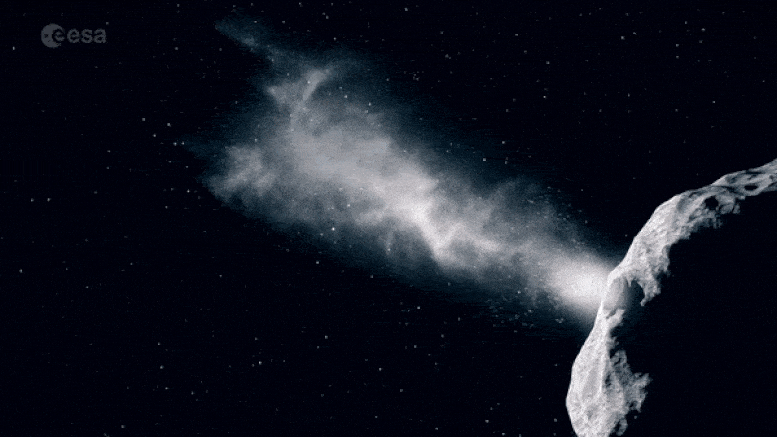NASA’s DART Spacecraft Sets Sights on Asteroid Target

NASA’s DART spacecraft is due to collide with the smaller body of the Didymos binary asteroid system in September 2022. Credit: ESA–ScienceOffice.org
poses no threat to Earth, this is humanity’s first test of the kinetic impact technique, using a spacecraft to deflect an asteroid for planetary defense.
This image (below) of the light from asteroid Didymos and its orbiting moonlet Dimorphos is a composite of 243 images taken by the Didymos Reconnaissance and Asteroid Camera for Optical navigation (DRACO) aboard DART on July 27, 2022.
From this distance—about 20 million miles away from DART—the Didymos system is still very faint, and navigation camera experts were uncertain whether DRACO would be able to spot the asteroid yet. However, once the 243 images DRACO took during this observation sequence were combined, the team was able to enhance it to reveal Didymos and pinpoint its location.

This image of the light from asteroid Didymos and its orbiting moonlet Dimorphos is a composite of 243 images taken by the Didymos Reconnaissance and Asteroid Camera for Optical navigation (DRACO) aboard DART on July 27, 2022. Credit: NASA JPL DART Navigation Team
“This first set of images is being used as a test to prove our imaging techniques,” said Elena Adams. She is the DART mission systems engineer at the Johns Hopkins Applied Physics Laboratory (APL) in Laurel, Maryland. “The quality of the image is similar to what we could obtain from ground-based telescopes, but it is important to show that DRACO is working properly and can see its target to make any adjustments needed before we begin using the images to guide the spacecraft into the asteroid autonomously.”
A number of navigation simulations using non-DRACO images of Didymos have already been conducted by the team. However, DART will ultimately depend on its ability to see and process images of Didymos and Dimorphos, once it too can be seen, to guide the spacecraft toward the asteroid, especially in the final four hours before impact. At that point, DART will need to autonomously self-navigate to impact successfully with Dimorphos without any human intervention.
“Seeing the DRACO images of Didymos for the first time, we can iron out the best settings for DRACO and fine-tune the software,” said Julie Bellerose, the DART navigation…
Read More: NASA’s DART Spacecraft Sets Sights on Asteroid Target
